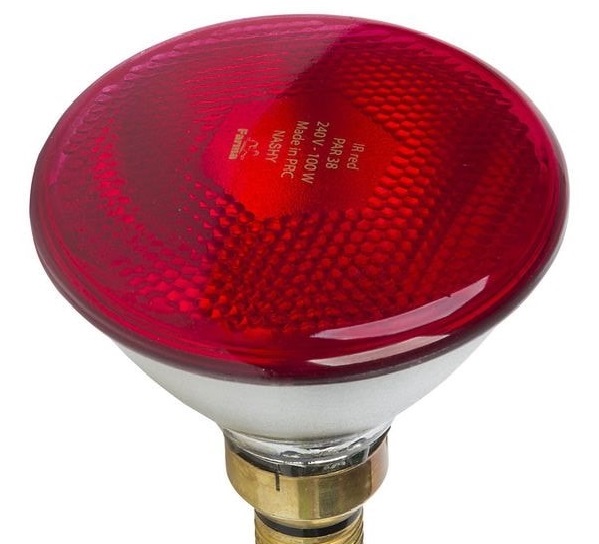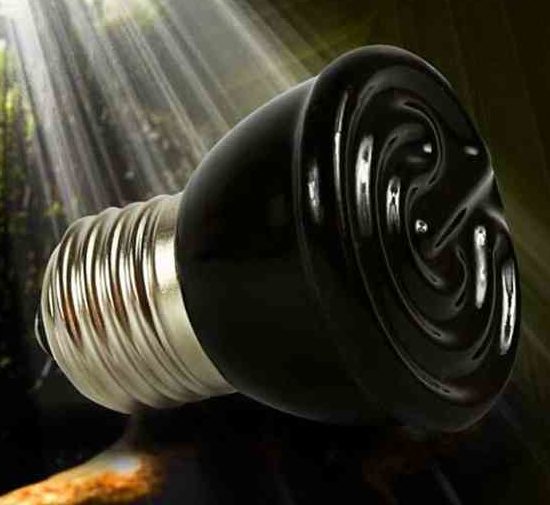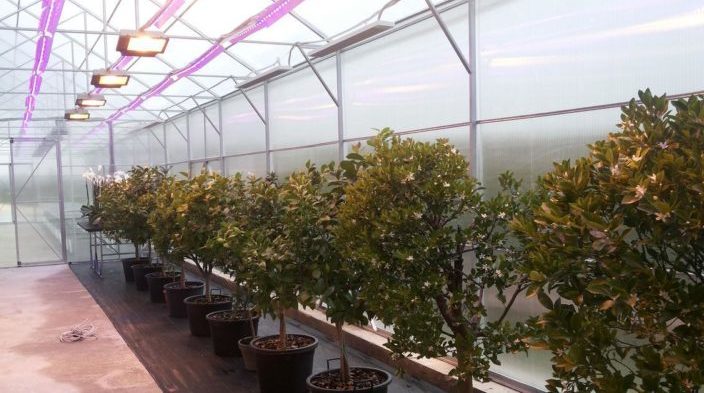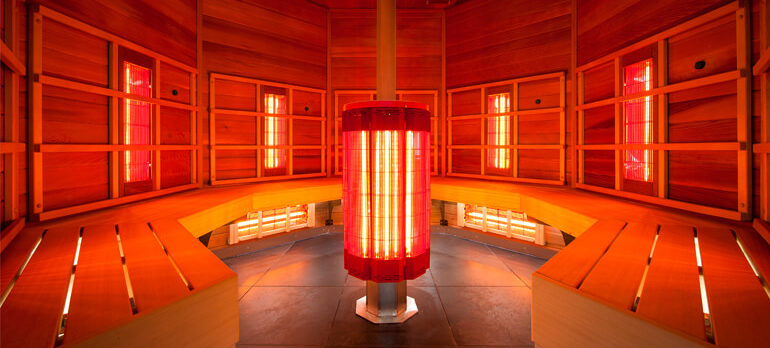Characteristics and models of infrared lamps
Among the various sources of lighting, the infrared lamp is in high demand. Its choice is obvious: room heating, treatment of diseases, drying paint mixes and more. Let's consider the features of functioning, types, advantages and disadvantages of the infrared lamp.
What is an infrared lamp
A device that emits electromagnetic waves, includes the same components as a light source with a tungsten filament. An infrared lamp contains:
- an incandescent element;
- A glass bulb filled with a mixture of gases
- base.
When tungsten is heated to a temperature above 570°C, energy is released. In infrared lamps, infrared luminescence is provided by electromagnetic oscillations. A mixture of argon and nitrogen inside a glass bulb and a filament create the conditions for heat release in the infrared range.

The infrared waves cannot be seen visually, but the temperature rise in the room can be felt. To change the color of the energy emitted, manufacturers make the bulbs blue and red. The colors regulate the light flux and minimize the risk of skin burns and visual impairment.
Varieties
Manufacturers offer lamps:
- without a mirror coating;
- with a red bulb;
- with a blue bulb;
- with a reflector;
- ceramic.
Without mirror coating
This is a device with external reflective elements. It is used for lighting and heating of rooms. The principle of operation of IR lamps, not equipped with a mirror coating, and halogen devices is identical. IKZ marking.
With red bulb
The lighting format labeled as IKZK. On the inside, the product is equipped with a mirror coating that optimizes the delivery of the infrared rays in the right direction. A carbon/tungsten filament is used as the heating element. The application of the red bulb lamp is to maintain the correct temperature in the rooms intended for growing plants and keeping livestock.

With blue bulb
A variation of the product that is labeled as IKZS. The lamp is equipped with a mirror coating, the bulb is colored blue. The device is recommended for the treatment of ENT diseases.
With a reflector
A model of illumination, the bulb of which in the upper part is treated with mirrored elements. A powerful light and heat flow is produced by the reflector. The product is marked with the letter R.
Ceramic lamp
Source of light for heating small areas or individual objects. The lamp is equipped with a ceramic housing for mechanical strength and resistance to temperature fluctuations. Fennel and nichrome heating element.

Device
Infrared elements are self-contained light sources that operate from the electric grid. They are made on the basis of lamps with tungsten filament. But by emitting electromagnetic radiation, infrared lamps do not heat the air in the room, but nearby objects that absorb the heat waves, then give them back, resulting in an increase in room temperature. In some devices, the infrared flux is distributed along a preset vector. They are in demand if a limited space needs to be heated. IR lamps are more economical than convectors and oil type radiators.
The power of the product, in which electricity is transformed into thermal radiation, can reach 50-500 watts. The bulb is made of standard or pressed glass. Often infrared elements are equipped with an E27 socket. Plastic sockets should not be used for infrared heat sources because they can melt if the lamp heats up to 80°C.
In contact with the switched on device increases the risk of burns, so it is additionally equipped with a protective grid. To increase the heating area, it is recommended to mount the IR lamp under the ceiling.
Tips to watch video: The simplest heater from a light bulb with his own hands
Selection criteria
The choice of the device depends on the purpose of its use. Let's consider the main criteria that are taken into account when buying an IR element.
Power
Depends on how much meterage of the room will be heated. For small rooms, choose infrared lamps with a power of 100-150 W. If the area is large, devices for 200-300 watts are used.
For maximum energy efficiency, it is necessary to take into account the characteristics of the power supply network. A significant portion of foreign-made models are powered by a 240 V outlet.
Recommended for viewing: Help in choosing infrared lamps.
Protection against overheating
Modern IR element formats can switch off automatically after as little as 15 minutes of operation. In some product variations the timer is set manually.
Budget versions of the lamps, in which electrical energy is transformed into thermal energy, are not always equipped with a mechanism that balances the risk of overheating.
Wavelength
Each model of IR element is differentiated by the amount of light and heat emitted. Maximum brightness is given by devices with short wavelengths (780-1400 nm). If dim light is needed, lamps with long wavelengths (3,000-10,000 nm) are chosen.

Labeling
Manufacturers of products apply the following designations - "R", "BR" and "PAR".
The first format of the IR element has a thin glass bulb and a glossy surface. The infrared lamp is recommended for heating rooms up to 16 m2. The angle of illumination reaches 60 °. Lamps marked "R" are fragile, easily broken, and are sold at a price of 150-250 rubles.
The light transmitting part of products designated by the abbreviation "BR" consists of tempered/compressed glass. The lightweight bulb is designed to last a long time. It is more durable than the IR element marked "R". Convex cell reflector ensures proper conductivity and reflectivity of electromagnetic waves. Lamps marked "BR" do not fail when exposed to moisture. They are often installed in bathrooms and saunas. Products can be purchased at a price of 300 to 400 rubles.
In the manufacture of infrared lamps marked "PAR" is used tempered glass. The basis of the light transmitting part is compressed material with special cells. They direct electromagnetic pulses to the working surface. The product is recommended for livestock farms. The cost of infrared elements marked "PAR" reaches 500-900 rubles.
Scope of application
The infrared lamp is used as the main or additional source of heating in industry and at home. Infrared elements save energy, so they are in demand and used in areas intended for plant and animal growth.

Space heating
A halogen heat emitter is used to increase the air temperature in rooms of various formats. Even with a modest wattage, it is able to heat large objects.
IR elements are often installed on porches of houses, in open-air catering facilities and gazebos.
To maintain a positive temperature in offices, apartments and houses, many people prefer to buy an infrared source. An infrared element with a medium wavelength creates a comfortable environment in the living room. Often the lamps are used as additional heating. As the main source of heat, the IR lamp with long wavelengths is relevant for the long term.
Thematic video: Heating the house with conventional lamps.
Heating greenhouses
Gardeners prefer to maintain a plus temperature in greenhouses with the help of IR elements. The devices are effective for spot lighting. Heating the plants provokes their growth in the vertical plane. Under the influence of infrared light, the crops actively produce chlorophyll, even in winter. With infrared lamps, gardeners can regulate the rate at which plants germinate and flower.
Heating for animals
Products that emit electromagnetic waves are used by farmers raising poultry and livestock. Infrared light protects brood geese, ducklings, chickens, and turkeys from winter cold, which contributes to their normal growth.
A stand-alone lamp with a temperature control option is required to heat a nursery in which animals are housed. After calving, lambs, calves and piglets are taken away from the adults and placed in sections where heat is provided by infrared elements.

Treatment of diseases
Several decades ago, infrared rays were actively used for therapeutic purposes. They continue to be used to treat
- diseases of the musculoskeletal system;
- hypertension;
- colds;
- Dermatological pathologies.
IKZS lamps improve well-being, normalize metabolism and strengthen immunity.

Use in the home
Electromagnetic waves are used to heat up cooking dishes, dry herbs and spices in the home. Remote infrared devices transmit infrared rays from a distance to control air conditioners, TVs and other home appliances.
Manufacturers
The world leaders in supplying IR lamps are: Philips (Netherlands), Osram (Germany), General Electric (USA), InterHeat (South Korea). In manufacturing, they use high quality raw materials, which provides their products with a maximum service life (over 6000 hours).
Lighting devices from the company "Philips" are resistant to moisture, so their cost is higher than domestic counterparts. Dutch products are used for heating greenhouses, livestock farms, rooms designed for bathing.
Infrared lamps rated at 150-375 W by the German company Osram are used for drying paintwork.
Products of InterHeat are in demand among farmers who raise young poultry.
Reflector lamps "General Electric" are used for lighting apartments and office space.
Advantages and disadvantages
To minimize the risk of burns, you need to maintain a certain distance from the source of electromagnetic waves (1-1.5 m).
Conclusion
Energy efficiency, cost-effectiveness, health benefits, ease of installation and a variety of applications - the reasons for choosing infrared lamps. They are a worthy alternative to fluorescent devices, LED elements and traditional lighting sources.
